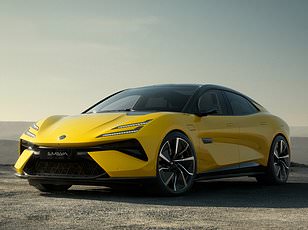Lotus Eletre is an electric Lamborghini Urus rival - but is it any good? We put the hyper-SUV to the test
- Lotus' all-electric Hyper-SUV showcases the new direction the British brand's Chinese owner is taking
- Eletre has the Lotus heart and traditional driver focus but with a new edge - we tested the £104,500 Eletre S
- Can it match-up against the V8 petrol Lamborghini Urus super-SUV? Battery range is not what's predicted
Lotus has a rich history – and it holds a place in the heart for many British car enthusiasts.
And while other manufacturers pump out new models all the time, a completely new Lotus is quite an event.
So, when Lotus unveiled the all-electric Eletre Hyper-SUV in 2022, it was a groundbreaking moment for the brand from Hethel. Afterall, Lotus only offers four models currently.
The Eletre - which means 'coming to life' in some Eastern European languages -followed the 2019 all-electric Evija hypercar, the company's first model with an electric powertrain.

We had the Lotus Eletre - Lotus' £104,500 hyper-SUV EV - in for a week of driving. Is it worth the money and can it truly rival a thunderous Lamborghini Urus with a big V8?
This luxury hyper-SUV is the size of a Range Rover, has the battery range to match a Mercedes EQS SUV and performance to keep up with a Lamborghini Urus - but at a fraction of the price of the twin-turbo petrol Lambo.
We test drove the Eletre over a week to see if this attention-grabbing EV is worth splurging around £100,000 of your hard-earned cash...
Lotus – British heritage, Chinese owned
Lotus was founded in 1948 in London by Colin and Hazel Chapman, and has gone on to produce some iconic vehicles, and unforgettable moments of racing history.
Colin, RAF pilot turned race car builder, created the Mark 1 Lotus from a re-engineered 1928 Austin Seven.
In 1956, the Lotus Eleven kickstarted the Lotus tradition of model names beginning with 'E'. And from then on when someone says Elise or Emira, you just know - Lotus.
Ten years later, in 1966, Lotus settled at the Hethel factory in Norfolk with its 2.5-mile race track.
By this point the Type 25, driven by Jim Clark, had won the 1963 Formula One Constructors' and Drivers' title for Lotus.

Colin Chapman, co-founder of Lotus created the Mark 1 Lotus from a re-engineered 1928 Austin Seven

His co-founder was his girlfriend turned wife Hazel, and Lotus ' design principle has always been: 'Adding power makes you faster on the straights, subtracting weight makes you faster everywhere'
The famous Chapman philosophy of 'adding power makes you faster on the straights, subtracting weight makes you faster everywhere' went from strength-to-strength on road and on track.
But fast-forward to the '90s and 2000s, and Lotus was struggling to balance high investment costs and low-volume output. Then after two decades in the red, Lotus was sold in 2017 to Geely – the Chinese automotive giant – who bought a 49.9 per cent stake.
Last year, it was announced that Geely wants to turn the British sports car maker into a premium EV brand, with three new cars in four years.
The Eletre is 'Born British, Raised Globally', Lotus says, with collaboration between the UK, Germany and the manufacturing plant in... Wuhan.
Sheer scale – it's a beast of a car – help or a hindrance?
We all know cars are getting bigger – there are some mammoth SUVs on the roads, and the Eletre is right up there with bulkiest of all.
It's 5,103mm long by 2,019mm wide and 1,636mm high; it's pretty much the exact dimensions of the Lamborghini Urus (5112mm x 2016mm x 1638mm).
For reference, both of these hulking SUVs are longer and wider than the new Range Rover (though the Range Rover is about 200mm taller).
I drove the Eletre around London, to Wittering on the south coast, to Bedfordshire and Canterbury within a week, and there's no way it's a car that makes sense in a city.

The Eletre is 5,103mm long by 2,019mm wide and 1,636mm high - pretty much the exact dimensions of the Lamborghini Urus (5112mm x 2016mm x 1638mm) - which is HUGE
At one point I turned into a road in East London only to see the width restriction bollards and immediately U-turned to find an alternative route - we were never going to fit.
This is an across-the-board issue with SUVs these days.
It's not just Eletre to be fair: Green campaign group Transport & Environment (T&E) found that 'mega SUVs' are 220cm wider (including their wing mirrors) than in 2017, and that half of new cars are too wide for on-street parking bays.
But considering EVs are so good for city travel, and the Lotus is a joy to drive, it's a pity that you spend a lot of your time worrying you'll get a ticket for being over the white line, or petrified of curbing an expensive alloy.
Though if you're spending £100k-plus on a hyper-SUV, an kerbed alloy or parking ticket is unlikely to do your bank balance much damage...
This is slightly counteracted by one particular driver assist: the parking cameras show a 360 birds-eye view, and, oh so helpfully the front and rear cameras also have a centimetre measurement feature.
The screen shows the precise distance to the obstacle in front and behind – a godsend.

Parking in cities and towns meant I was frequently over the lines , no matter how alloy-kerbingly-close I got to the pavement
Is it practical?
For an environmentally-conscious buyer who is more than happy to have a somewhat immovable Chelsea Tractor, then it's a very space-friendly car.
At one point a bag slid right up against the rear seats, and I had to climb into the boot to retrieve it - the 688-litre load space goes back that far.
It's over 70 litres bigger than the Urus, although 37 litres less than the new five-seater Range Rover.
The Mercedes EQS SUV has a 610-litre boot, and the BMW iX just 500 litres, if you wanted a little more perspective.
There's also 45-litre froot (front boot) for the AC charging cable, although the shape wasn't very practical for stuffing the cable in. Annoyingly, you had to open it by pulling a lever twice by the passenger's feet which was a bit faffy.
But the cabin is very spacious, and great for families.
What's the interior like?
There are four or five-seat layout options available to customers.
I had a five-seater, which came with a £2,000 Comfort Pack option.
This added eight-way adjustable and heated front seats, four-way front seat lumbar support and memory front seats (which remembers driver and passenger preferred settings).
The Eletre is the first Lotus to have the new Hyper OS infotainment system, which was clear, easy to find your way (around for the most part) and looks brilliant.
I especially loved the sleek, super skinny 12.6-inch OLED instrument cluster behind the steering wheel, that works in perfect tandem with the 29-inch head-up display.
It doesn't distract from driving, and you get the full enjoyment of the flat-bottomed wheel and flappy paddles without a glaring screen behind.
And I really liked the way the light moves across the strip screen while the car charges.

I especially loved the sleek, super skinny 12.6-inch OLED instrument cluster behind the steering wheel, that works in perfect tandem with the 29-inch head-up display

The Eletre is the first Lotus to have the new Hyper OS infotainment system. The main infotainment screen is a 15.1-inch setup which powers up with the Eletre highlighted against the Lotus yellow background

The red contrast seat belts against the charcoal grey/black seats, and red stitching throughout the cabin gave a tough sporty feel too
The main infotainment screen is a 15.1-inch setup which welcomes you by highlighting the Eletre against a Lotus yellow background.
The front passenger also has a touchscreen strip - good if you've got adult passengers, but annoying if you've got tap-happy kids – and there's of course Apple CarPlay and Android Auto in-built.
The drive selector is housed in the centre console, along with quick access buttons and a wireless charging pad. The storage console is decent but the push down cup holders are a bit of a bugbear and could be bigger.
The interior is superbly finished – proper luxury that can hold its own against a Range Rover or a Urus that might end up costing almost double an Eletre.
The red contrast seat belts against the charcoal grey/black seats, and red stitching throughout the cabin gave a tough sporty feel too.

There are four or five-seat layout options available - the Eletre S I had had five seats and came with the £2,000 Comfort Pack
Sustainability is a key theme of the interior.
Lotus has brought in 'Re-Fibre' with the Eletre, which is made from fashion industry waste fabric, – it feels like a mix between cotton and silk – as well as carbon neutral Alcantara and Econyl carpets made from recycled consumer waste.
One of the first things I do when I jump in a new car is to hook up my Spotify and test out the sound system: The Eletre S has a very decent KEF Premiun 23-speaker surround system with Dolby Atmos.
You can change the settings on the info system from 'Spatial' to 'Stage' which, as the name suggests, blasts the music out as if you're front row at a show.
For jamming on a solo road trip this was perfect.
What's it like to drive?
The Eletre S has 603hp, can hit 0-to-62mph in 4.5 seconds and has a max speed of 160mph (the Urus has 650hp).
I have also driven the absolutely bonkers 905hp Eletre R on track and while wildly fun, 603hp is more than enough for even the most performance-loving driver.
The front and rear axle electric motors make the Eletre Lotus' first all-wheel road car.
You can feel the low centre of gravity (thanks to the battery sitting between the axles), and the suspension and stiff body structure is core Lotus DNA.
It sets off on Tour mode but you can change to Off-road (not sure when you'd actually ever use that), Range, Sports and Individual – just flick through using the right steering wheel paddle.
Sport firms up the seats, lowers the car and stiffens up the ride quality as expected. And it steers brilliantly.

The Eletre S has 603hp, can hit 0-to-62mph in 4.5 seconds and has a max speed of 160mph (the Urus has 650hp)

It handles the close to 2.5 tonne weight well, although caution and full attention is required on tighter country bends
It's really a very put together drive and it glides over bumps.
On the motorway I feel it comes into its own, but beware it is dangerously easy to speed because of its mid-speed acceleration. And the brakes are sharp - a bit too sharp for everyday cruising to be honest.
It handles the close to 2.5-tonne weight well, although caution and full attention is required on tighter country bends.
And the rear spoiler - which deploys when driven at high speeds and generates up to 112.5 kg of downforce - is both road handling beneficial and a nice sports car flare.
I was very relieved that the S came with normal wing mirrors and not the electronic cameras the R I previously drove had. Wing mirror cameras are a technological invention no-one needs, but on a car this big it's almost dangerous because you're so reliant on checking your mirrors.
Okay, it's quick, but how much range does it have?
This is the where the driving joy gives way to frustration.
The claimed range is 373 miles on a single charge (the Eletre has a 112kWh battery), but it gobbles through that far more rapidly than the brochure tells you.
And putting it into Range mode didn't really seem to help - roughly I seemed to get about 65 per cent of the range I was told.
So I wouldn't be confident trusting the predicted range – and range anxiety isn't something I suffer from usually. This also meant I paid a lot more than expected to charge over the week (I rely on public charging).

The main issue with this car is that range just isn't anywhere near what's stated - I was getting around 65% of what was predicted on the car's system
How long does it take to charge?
The 112kWh battery for both versions has a charging time (10 per cent to 80 per cent) of just 20 minutes using a 350kW DC ultra-rapid charger. You get 74 miles of range in five minutes.
AC charging is capped at 22kW, giving you a fall charge in around six hours.
The charging port is very well designed: it opens either via the infotainment screen or by pressing on the charging port cover, and then it's a simple button next to the port to close.

The Eletre charges from 10-80% in just 20 minutes using a 350kW DC ultra-rapid charger
It's as long as a barge, but does it look good?
I don't think I've ever driven a car in London that has garnered so much attention. Or anywhere honestly.
Even in a packed Wittering field 'car park' on the way to the beach, people were staring. And it's obviously not because of the noise - it's a silent ghost.
You can see heads swivel 180 degrees as you drive past, and the 'there's a Urus… wait no it's not…and it's electric… what is that?' thought process running through people's minds like the cogs in a well-oiled machine.
It looks fantastic in my opinion.
The front has the Esprit-esque flat nose, a dominating open-mouth black grille and angular aerodynamic cut outs. Even the daytime running lights are broody.
The two-curved blade front spoiler and rear spoiler make it look like a predatory fish or crocodile (in a good way).
And the sheer road presence is increased by the 23-inch alloys with red calipers.

You can see heads swivel 180 degrees as you drive past, such is the general scale and look of this electric beast

The front has the Esprit-esque flat nose, a dominating open mouth black grille and angular aerodynamic cut outs. Even the daytime running lights are broody
The Cars & Motoring verdict
Considering the base Eletre starts at £89,500, you really get a lot of car for the price point.
Even the S - costing £104,500 - is massive value for money compared to a £188,000 Urus.
And it's so much more fun to drive than the £102,025-starting price Range Rover.
If it wasn't for the range issue, the Lotus Eletre could be among the best performance-SUV models sold in British showrooms.
But even with the less than expected range, for a deep-pocketed buyer after an unnecessary - but thrilling - second car, then why not? Especially if you can charge at home.
It will definitely be a talking point down the pub and will undoubtedly make you appear more interesting than a Urus or Range Rover owner.
CARS & MOTORING: ON TEST
-
 Hyundai Inster review: Is it the affordable EV we've been waiting for?
Hyundai Inster review: Is it the affordable EV we've been waiting for? -
 The most controversial new car of 2024: We drive the Ford Capri EV
The most controversial new car of 2024: We drive the Ford Capri EV -
 Has Vauxhall's grand plans for its new Grandland SUV paid dividends?
Has Vauxhall's grand plans for its new Grandland SUV paid dividends? -
 Aston Martin Vanquish: Britain's new brute of a sports car tested
Aston Martin Vanquish: Britain's new brute of a sports car tested -
 Renault 5 EV: Can it recreate the character and charm of the original?
Renault 5 EV: Can it recreate the character and charm of the original? -
 Polestar 4 EV: The first car sold in Britain WITHOUT a rear window
Polestar 4 EV: The first car sold in Britain WITHOUT a rear window -
 We take to the wheel of Ferrari's stunning new £336k 12Cilindri GT car
We take to the wheel of Ferrari's stunning new £336k 12Cilindri GT car -
 China's new sub-£16k EV: Leapmotor T03 arrives in UK with low price
China's new sub-£16k EV: Leapmotor T03 arrives in UK with low price -
 Peugeot E-5008: Is the £49k SUV the choice for eco-conscious families?
Peugeot E-5008: Is the £49k SUV the choice for eco-conscious families? -
 Ducati's new £30,000 Panigale V4 S costs the same as a small Mercedes
Ducati's new £30,000 Panigale V4 S costs the same as a small Mercedes -
 Is the new £22k MG ZS hybrid family-friendly SUV a genuine bargain?
Is the new £22k MG ZS hybrid family-friendly SUV a genuine bargain? -
 This £100k Volvo has driven me to distraction: EX90 SUV driven
This £100k Volvo has driven me to distraction: EX90 SUV driven -
 VW Touareg is a luxury SUV for a lower price - why is it so unpopular?
VW Touareg is a luxury SUV for a lower price - why is it so unpopular? -
 We test the new MG HS - Britain's favourite budget-friendly family SUV
We test the new MG HS - Britain's favourite budget-friendly family SUV -
 We test drive the £15,000 Dacia Spring - the UK's CHEAPEST new EV
We test drive the £15,000 Dacia Spring - the UK's CHEAPEST new EV -
 Suitable for UK climates: You can enjoy Mercedes CLE Cabrio year round
Suitable for UK climates: You can enjoy Mercedes CLE Cabrio year round -
 Kia's affordable Picanto offers a fun and nippy drive in the big city
Kia's affordable Picanto offers a fun and nippy drive in the big city -
 MG Cyberster review - convertible EV costs £60k and is fun to drive
MG Cyberster review - convertible EV costs £60k and is fun to drive -
 'Euros' winning Renault Scenic E-Tech gets Ray Massey's vote
'Euros' winning Renault Scenic E-Tech gets Ray Massey's vote -
 Ford Explorer: Is the £40k electric SUV a good buy for UK drivers?
Ford Explorer: Is the £40k electric SUV a good buy for UK drivers? -
 Polestar 3: Does the Tesla Model Y now have a real fight on its hands?
Polestar 3: Does the Tesla Model Y now have a real fight on its hands? -
 Lotus Eletre is an EV Lamborghini Urus rival: The hyper-SUV tested
Lotus Eletre is an EV Lamborghini Urus rival: The hyper-SUV tested -
 Dacia's new Duster is here - has it lost its value-for-money appeal?
Dacia's new Duster is here - has it lost its value-for-money appeal? -
 Alfa Romeo Tonale review: Can this SUV bring some sporting thrill?
Alfa Romeo Tonale review: Can this SUV bring some sporting thrill? -
 In a world of SUVs, can the VW Passat re-energise the estate market?
In a world of SUVs, can the VW Passat re-energise the estate market? -
 Ineos Quartermaster review: The new premium pick-up truck in town
Ineos Quartermaster review: The new premium pick-up truck in town -
 Peugeot e-3008 is attractive, sprightly and has a 326-mile range
Peugeot e-3008 is attractive, sprightly and has a 326-mile range -
 New £165k Aston Martin Vantage tested - is it better than a Ferrari?
New £165k Aston Martin Vantage tested - is it better than a Ferrari? -
 Can BMW harness the magic of the original Mini in an EV made in China?
Can BMW harness the magic of the original Mini in an EV made in China? -
 Is this the ultimate open-top super tourer? Aston Martin DB12 Volante
Is this the ultimate open-top super tourer? Aston Martin DB12 Volante -
 New Fiat 600e EV family car is here, but should wait for the hybrid?
New Fiat 600e EV family car is here, but should wait for the hybrid? -
 VW Tiguan review: Brand's best-selling SUV is back - but is it better?
VW Tiguan review: Brand's best-selling SUV is back - but is it better? -
 Should you consider the Mini Countryman EV instead of the petrol?
Should you consider the Mini Countryman EV instead of the petrol? -
 Another BMW goes electric - we test the new iX2 vs its petrol X2 rival
Another BMW goes electric - we test the new iX2 vs its petrol X2 rival -
 The 2024 Range Rover Evoque plug-in hybrid is a home-grown winner
The 2024 Range Rover Evoque plug-in hybrid is a home-grown winner -
 Britain's favourite car DRIVEN - we review the best-selling Ford Puma
Britain's favourite car DRIVEN - we review the best-selling Ford Puma -
 BMW's i5 EV offers supercar performance in an exec saloon package
BMW's i5 EV offers supercar performance in an exec saloon package -
 We drive the £76,000 Kia EV9 - Korea's all-electric Range Rover rival
We drive the £76,000 Kia EV9 - Korea's all-electric Range Rover rival -
 Has the BMW M3 Touring been worth the three-decade wait? Our review
Has the BMW M3 Touring been worth the three-decade wait? Our review -
 Has Britain's most popular small car just got much better? New Corsa
Has Britain's most popular small car just got much better? New Corsa -
 Volvo EX30 review: Sweden's new 'green' pocket rocket SUV rival Tesla
Volvo EX30 review: Sweden's new 'green' pocket rocket SUV rival Tesla -
 Is Renault's new Austral E-Tech SUV the complete package? We drive it
Is Renault's new Austral E-Tech SUV the complete package? We drive it -
 The Audi Q8 is annoyingly good for a 'sporty' coupe-style SUV
The Audi Q8 is annoyingly good for a 'sporty' coupe-style SUV -
 Ferrari Roma Spider costs £210k - here's what you get for your money
Ferrari Roma Spider costs £210k - here's what you get for your money -
 China's all-electric BYD Dolphin lands ashore - we test it on UK roads
China's all-electric BYD Dolphin lands ashore - we test it on UK roads -
 Our epic road test through Demark and Sweden in the new Polestar 2
Our epic road test through Demark and Sweden in the new Polestar 2 -
 New Abarth 500e convertible is a rare treat - it's electric and sporty
New Abarth 500e convertible is a rare treat - it's electric and sporty -
 Honda's new CR-V is bigger than its predecessor - but is it better?
Honda's new CR-V is bigger than its predecessor - but is it better? -
 We beat the new Bond to test his new car: Aston Martin DB12 review
We beat the new Bond to test his new car: Aston Martin DB12 review -
 Behind the wheel of Rolls-Royce's Spectre: We test the new EV Roller
Behind the wheel of Rolls-Royce's Spectre: We test the new EV Roller -
 Skoda's crowning glory: Superb L&K 4x4 Estate with extras driven
Skoda's crowning glory: Superb L&K 4x4 Estate with extras driven -
 Maserati Grecale test - the SUV with 50% of sales projected for women
Maserati Grecale test - the SUV with 50% of sales projected for women -
 Dacia's budget family car with seven seats! The £18,000 Jogger tested
Dacia's budget family car with seven seats! The £18,000 Jogger tested -
 This Q8 is just great: We take Audi's new Sportback e-tron for a spin
This Q8 is just great: We take Audi's new Sportback e-tron for a spin -
 Enter the Dragon! BYD Atto EV is the Chinese company's first UK model
Enter the Dragon! BYD Atto EV is the Chinese company's first UK model -
 Ferrari's first four-door family car: New £313,000 Purosangue driven
Ferrari's first four-door family car: New £313,000 Purosangue driven -
 Thrills without frills: £31,000 MG5 is one of the cheapest family EVs
Thrills without frills: £31,000 MG5 is one of the cheapest family EVs -
 Renault's Arkana ticks all the boxes for what car-buying Britons want
Renault's Arkana ticks all the boxes for what car-buying Britons want -
 Can Peugeot's chic 408 hybrid crossover be a hit in the UK? We test it
Can Peugeot's chic 408 hybrid crossover be a hit in the UK? We test it -
 We drive the Civic Type R - the rebellious bad boy in Honda's line-up
We drive the Civic Type R - the rebellious bad boy in Honda's line-up -
 Rolls Royce Spectre: What's it lke to drive the first ELECTRIC Roller?
Rolls Royce Spectre: What's it lke to drive the first ELECTRIC Roller? -
 Ineos Grenadier driven: Sir Jim Ratcliffe's £69,000 Defender
Ineos Grenadier driven: Sir Jim Ratcliffe's £69,000 Defender -
 Can you really live with a tiny Citroen Ami? Seven tasks in seven days
Can you really live with a tiny Citroen Ami? Seven tasks in seven days -
 Don't supersize me! Is the 'smaller' Volvo XC60 all the SUV you need?
Don't supersize me! Is the 'smaller' Volvo XC60 all the SUV you need? -
 We pamper some passengers in the new £211k Bentley Bentayga
We pamper some passengers in the new £211k Bentley Bentayga -
 New kind of Buzz! VW's electric MPV still feels like a hippy campervan
New kind of Buzz! VW's electric MPV still feels like a hippy campervan


















